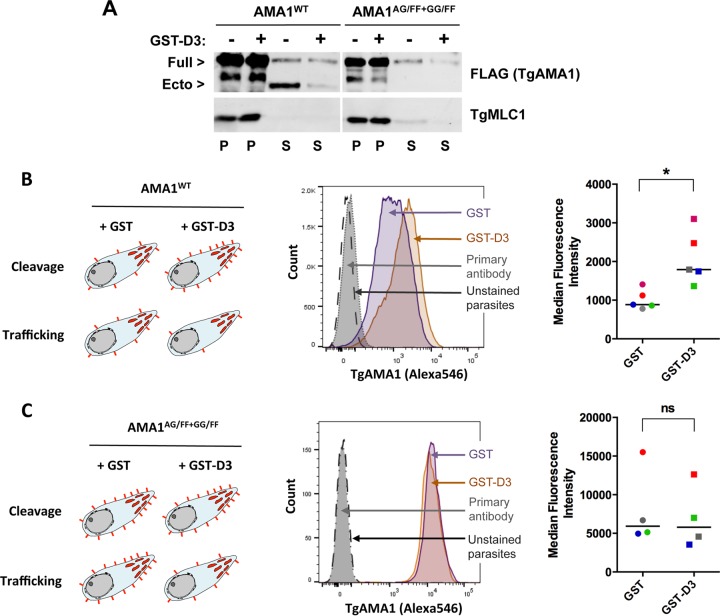FIG 2 .
GST-D3 causes reduced cleavage of TgAMA1 but not reduced trafficking to the parasite surface. (A) A microneme secretion assay was performed using conditional AMA1WT and AMA1AG/FF+GG/FF parasites treated with either 1 µM GST-D3 (+) or GST (−). Assay pellet (P) and supernatant (S) fractions are indicated. The decrease in shedding of TgAMA1 was evident in AMA1WT parasites treated with GST-D3 (compare AMA1WT supernatants with and without GST-D3). No shed ectodomain was detected using either GST- or GST-D3-treated TgAMA1AG/FF+GG/FF parasites (TgAMA1AG/FF+GG/FF supernatants with and without GST-D3). Full-length protein in the supernatant is likely due to parasite lysis. TgMLC1 was used as a loading control. (B, left) Schematic showing the two possible outcomes from treatment of AMA1WT parasites with GST-D3. If GST-D3 reduces cleavage of TgAMA1, we would expect more surface TgAMA1 (red spikes) after GST-D3 treatment than after GST treatment. If GST-D3 affects trafficking of TgAMA1 to the parasite surface, we would expect less TgAMA1 on the surface after GST-D3 treatment. (Middle) By flow cytometry, GST-D3 treatment resulted in an increase in surface TgAMA1 in AMA1WT parasites, consistent with an effect on cleavage. Representative histograms are shown. The dashed-line histogram represents unstained parasites, the gray histogram represents parasites stained with primary antibody only, the purple histogram represents parasites treated with GST, and the orange histogram represents parasites treated with GST-D3. Alexa546 indicates Alexa Fluor 546 fluorescence. (Right) Combined flow data from five biological replicates. The bars indicate the median values of the TgAMA1 signals. Paired samples from each experiment are indicated using symbols of the same color. The median values were significantly different (*, P = 0.0159) by a nonparametric two-tailed t test. (C, left) If GST-D3 inhibits cleavage, there would likely be no difference in the amount of TgAMA1 on the surface of GST-treated versus GST-D3-treated parasites expressing noncleavable TgAMA1 (AMA1AG/FF+GG/FF), since cleavage is already severely inhibited in these mutant parasites (see panel A). On the other hand, if GST-D3 affects trafficking of TgAMA1 to the parasite surface, we would expect less TgAMA1 on the surface of AMA1AG/FF+GG/FF parasites following treatment with GST-D3. (Middle and right) Flow cytometry (performed and analyzed as in panel B) showed that GST-D3 treatment had no significant (ns) effect (P = 0.6571) on the amount of AMA1AG/FF+GG/FF on the parasite surface, again consistent with an effect on cleavage rather than trafficking.

